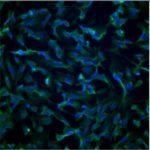Lien vers Pubmed [PMID] – 11160935
Nucleic Acids Res. 2001 Feb;29(4):E15
Sequence-specific recognition of DNA can be achieved by triple helix-forming oligonucleotides that bind to the major groove of double-helical DNA. These oligonucleotides have been used as sequence-specific DNA ligands for various purposes, including sequence-specific gene regulation in the so-called ‘antigene strategy’. In particular, (G,A)-containing oligonucleotides can form stable triple helices under physiological conditions. However, triplex formation may be in competition with self-association of these oligonucleotides. For biological applications it would be interesting to identify the conditions under which one structure is favoured as compared to the other(s). Here we have directly studied competition between formation of a parallel (G,A) homoduplex and that of a triple helix by a 13 nt (G,A)-containing oligonucleotide. Temperature gradient gel electrophoresis allows simultaneous detection of competition between the two structures, because of their different temperature dependencies and gel electrophoretic mobilities, and characterisation of this competition.

